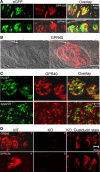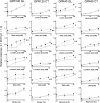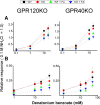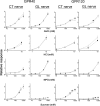Taste preference for fatty acids is mediated by GPR40 and GPR120 - PubMed (original) (raw)
Taste preference for fatty acids is mediated by GPR40 and GPR120
Cristina Cartoni et al. J Neurosci. 2010.
Abstract
The oral perception of fat has traditionally been considered to rely mainly on texture and olfaction, but recent findings suggest that taste may also play a role in the detection of long chain fatty acids. The two G-protein coupled receptors GPR40 (Ffar1) and GPR120 are activated by medium and long chain fatty acids. Here we show that GPR120 and GPR40 are expressed in the taste buds, mainly in type II and type I cells, respectively. Compared with wild-type mice, male and female GPR120 knock-out and GPR40 knock-out mice show a diminished preference for linoleic acid and oleic acid, and diminished taste nerve responses to several fatty acids. These results show that GPR40 and GPR120 mediate the taste of fatty acids.
Figures
Figure 1.
A, Photomicrographs of frozen sections of circumvallate papilla from transgenic mice expressing eGFP under the control of the Trpm5 promoter stained (red) with GPR120 (top) or GPR40 antibodies (bottom). The staining obtained with the GPR120 antibody is mostly colocalized with Trpm5 promoter-driven eGFP fluorescence. The GPR40 antibody stained mainly cells that do not express eGFP. With this antibody, staining is most intense in the taste pore (arrow). B, Microphotograph of a frozen section of foliate papilla from a wild-type mouse stained with a GPR40 antibody. Staining is most intense in the taste pore (arrow). The dotted line shows the boundary of the taste bud. C, Photomicrographs of frozen sections of circumvallate papilla from wild-type mice double-stained with GPR40 antibody (red) and GLAST (top, green) or SNAP25 (bottom, green) antibodies; Most GPR40-expressing cells also express GLAST and there is little coexpression of SNAP25 and GPR40. D, Photomicrographs of frozen sections of circumvallate papillae from wild-type (1, 4), GPR40 KO (2, 3) and GPR120 KO (5, 6) mice stained with GPR40 (1, 2), GPR120 (4, 5), or α-gustducin (3, 6) specific antibodies. The GPR120 and GPR40 proteins are not detected in the CV of GPR120 KO and GPR40 KO mice, respectively. Sections from GPR120 KO or GPR40 KO mice stained with α-gustducin antibody show that the knock-out mice have normal taste buds and type II cells, and that the expression of α-gustducin is not affected by the absence of GPR120 or GPR40.
Figure 2.
Mean preference ratios for tastants consumed during 48 h two-bottle preference tests comparing KO (open circles) and control mice (black squares). The mice were given two bottles, one with tastant and one with vehicle alone for 24 h then the bottles were swapped to eliminate position preferences and presented for an extra 24 h. The vehicle was 0.3% xanthan gum to mimic the viscosity of the fatty suspensions. The ratios of tastant to total liquid consumed over 48 h were measured and compared between groups. The GPR40 KO mice showed a diminished preference for linoleic acid and oleic acid. The GPR120 KO mice showed a diminished preference for linoleic acid. The dashed line indicates the indifference line. Asterisks indicate a significant difference in preference (*p < 0.05) when all concentrations are analyzed together; **p < 0.001. n = 10–15; error bars are SEM.
Figure 3.
Mean number of licks per trial during short access tests comparing linoleic acid (100 or 350 m
m
, open bars) and xanthan gum (gray bars). GPR40 KO, GPR120 KO and wild-type mice were tested. The mice were water and food restricted 23.5 h before the testing session, and then tested for 30 min in 5 s trials with one concentration of tastant and vehicle presented alternatively. The mean number of licks per 5 s trial was recorded. +p = 0.027, *p < 0.025, **p < 0.01. Error bars are SEM.
Figure 4.
CT and GL integrated whole nerve responses of control (black squares) and GPR120 KO or GPR40 KO (open circles) mice to lingual application of tastants. All responses were normalized to the response to 100 m
m
NH4Cl. GPR120 KO mice show diminished responses in both nerves to several fatty acids, whereas only the response of the GL nerve is affected in the GPR40 KO mice. The response to lauric acid is diminished in the GPR40 KO, but not in the GPR120 KO mice. There is no effect of mineral oil. Asterisks indicate a significant difference between KO and control, across all concentrations (*p < 0.05 and **p < 0.01, respectively). For each group and each nerve, n = 6–9. Error bars are SEM.
Figure 5.
A, B, Integrated whole nerve responses from the GL (A) and CT (B) nerves. Denatonium benzoate was tested in the absence (KO, red circles; control, black squares) or presence (KO, inverted blue triangle; control, green triangle) of a mix of 55 μ
m
linoleic acid and 33 μ
m
oleic acid. KO groups are GPR120 KO (left) and GPR40 KO (right). There is no difference in responses to denatonium between KO and control mice. The fatty acid mix reduces the nerve response to denatonium, but this effect is GPR120 and GPR40 independent. Error bars are SEM.
Figure 6.
CT and GL integrated whole nerve responses of control (black squares) and GPR120 KO or GPR40 KO (open circles) mice to lingual application of tastants. All responses were normalized to the response to 100 m
m
NH4Cl. There is no significant difference between KO and control in the nerve responses to NaCl, HCl, monopotassium glutamate (MPG), and sucrose. Error bars are SEM.
Similar articles
- Activation of tongue-expressed GPR40 and GPR120 by non caloric agonists is not sufficient to drive preference in mice.
Godinot N, Yasumatsu K, Barcos ME, Pineau N, Ledda M, Viton F, Ninomiya Y, le Coutre J, Damak S. Godinot N, et al. Neuroscience. 2013 Oct 10;250:20-30. doi: 10.1016/j.neuroscience.2013.06.043. Epub 2013 Jul 4. Neuroscience. 2013. PMID: 23831422 - GPR40 and GPR120 fatty acid sensors are critical for postoral but not oral mediation of fat preferences in the mouse.
Sclafani A, Zukerman S, Ackroff K. Sclafani A, et al. Am J Physiol Regul Integr Comp Physiol. 2013 Dec 15;305(12):R1490-7. doi: 10.1152/ajpregu.00440.2013. Epub 2013 Oct 23. Am J Physiol Regul Integr Comp Physiol. 2013. PMID: 24154510 Free PMC article. - G protein-coupled receptors in human fat taste perception.
Galindo MM, Voigt N, Stein J, van Lengerich J, Raguse JD, Hofmann T, Meyerhof W, Behrens M. Galindo MM, et al. Chem Senses. 2012 Feb;37(2):123-39. doi: 10.1093/chemse/bjr069. Epub 2011 Aug 25. Chem Senses. 2012. PMID: 21868624 - CD36 and taste of fat.
Degrace-Passilly P, Besnard P. Degrace-Passilly P, et al. Curr Opin Clin Nutr Metab Care. 2012 Mar;15(2):107-11. doi: 10.1097/MCO.0b013e32834ff19c. Curr Opin Clin Nutr Metab Care. 2012. PMID: 22248592 Review. - Ca2+ signaling in taste bud cells and spontaneous preference for fat: unresolved roles of CD36 and GPR120.
Abdoul-Azize S, Selvakumar S, Sadou H, Besnard P, Khan NA. Abdoul-Azize S, et al. Biochimie. 2014 Jan;96:8-13. doi: 10.1016/j.biochi.2013.06.005. Epub 2013 Jun 15. Biochimie. 2014. PMID: 23774298 Review.
Cited by
- ERK1/2 activation in human taste bud cells regulates fatty acid signaling and gustatory perception of fat in mice and humans.
Subramaniam S, Ozdener MH, Abdoul-Azize S, Saito K, Malik B, Maquart G, Hashimoto T, Marambaud P, Aribi M, Tordoff MG, Besnard P, Khan NA. Subramaniam S, et al. FASEB J. 2016 Oct;30(10):3489-3500. doi: 10.1096/fj.201600422R. Epub 2016 Jun 29. FASEB J. 2016. PMID: 27358389 Free PMC article. - A systematic review of the biological mediators of fat taste and smell.
Jaime-Lara RB, Brooks BE, Vizioli C, Chiles M, Nawal N, Ortiz-Figueroa RSE, Livinski AA, Agarwal K, Colina-Prisco C, Iannarino N, Hilmi A, Tejeda HA, Joseph PV. Jaime-Lara RB, et al. Physiol Rev. 2023 Jan 1;103(1):855-918. doi: 10.1152/physrev.00061.2021. Epub 2022 Sep 15. Physiol Rev. 2023. PMID: 36409650 Free PMC article. Review. - Single-nucleotide polymorphism rs1761667 in the CD36 gene is associated with orosensory perception of a fatty acid in obese and normal-weight Moroccan subjects.
Bajit H, Ait Si Mohammed O, Guennoun Y, Benaich S, Bouaiti E, Belghiti H, Mrabet M, Elfahime EM, El Haloui NE, Saeid N, El Kari K, Hichami A, Khan NA, Benkirane H, Aguenaou H. Bajit H, et al. J Nutr Sci. 2020 Jun 30;9:e24. doi: 10.1017/jns.2020.18. eCollection 2020. J Nutr Sci. 2020. PMID: 32685140 Free PMC article. - Association Between Arachidonic Acid and Chicken Meat and Egg Flavor, and Their Genetic Regulation.
Takahashi H. Takahashi H. J Poult Sci. 2018;55(3):163-171. doi: 10.2141/jpsa.0170123. Epub 2018 Feb 25. J Poult Sci. 2018. PMID: 32055170 Free PMC article. Review. - Peripheral mechanisms in appetite regulation.
Camilleri M. Camilleri M. Gastroenterology. 2015 May;148(6):1219-33. doi: 10.1053/j.gastro.2014.09.016. Epub 2014 Sep 21. Gastroenterology. 2015. PMID: 25241326 Free PMC article. Review.
References
- Benton R, Vannice KS, Vosshall LB. An essential role for a CD36-related receptor in pheromone detection in Drosophila. Nature. 2007;450:289–293. - PubMed
- Bezençon C, le Coutre J, Damak S. Taste-signaling proteins are coexpressed in solitary intestinal epithelial cells. Chem Senses. 2006;32:41–49. - PubMed
- Briscoe CP, Tadayyon M, Andrews JL, Benson WG, Chambers JK, Eilert MM, Ellis C, Elshourbagy NA, Goetz AS, Minnick DT, Murdock PR, Sauls HR, Jr, Shabon U, Spinage LD, Strum JC, Szekeres PG, Tan KB, Way JM, Ignar DM, Wilson S, et al. The orphan G-protein-coupled receptor GPR40 is activated by medium and long chain fatty acids. J Biol Chem. 2003;278:11303–11311. - PubMed
- Chale-Rush A, Burgess JR, Mattes RD. Evidence for human orosensory (taste?) sensitivity to free fatty acids. Chem Senses. 2007;32:423–431. - PubMed
Publication types
MeSH terms
Substances
LinkOut - more resources
Full Text Sources
Other Literature Sources
Molecular Biology Databases





